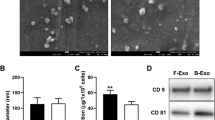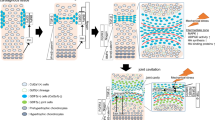Abstract
Chondromodulin-I (ChM-I) is a 25-kDa glycoprotein that specifically localizes in the extracellular matrix of cartilage and negatively regulates angiogenesis. ChM-I comprises two domains: an N-terminal hydrophilic domain (domain 1) containing an N-linked glycosylation site and a C-terminal hydrophobic domain (domain 2) with all four disulfide bonds that are present in this protein. We generated a nonglycosylated recombinant human ChM-I (NG-hChM-I) and compared its bioactivity with that of the glycosylated form of human ChM-I (G-hChM-I) expressed in Chinese hamster ovary cells in vitro. NG-hChM-I exhibited the growth factor/inhibitor activity in the cultures of chondrocytes and vascular endothelial cells but required markedly higher doses. Although domain 1 is predicted to be hydrophilic per se on the basis of its amino acid sequence, NG-hChM-I remains insoluble in aqueous solution as much as ΔN-hChM-I that lacks the N-terminal 37 amino acids containing an N-glycosylation site. Circular dichroism measurements revealed that the content of α-helix was calculated to be 34% in G-hChM-I, whereas the content of the characteristic secondary structures in NG-hChM-I was distinctly lower than those in G-hChM-I. These results indicate that glycosylation in domain 1 is critical for the structural integrity for biological functions of ChM-I in vitro.







Similar content being viewed by others
References
Hiraki Y, Tanaka H, Inoue H, Kondo J, Kamizono A, Suzuki F (1991) Molecular cloning of a new class of cartilage-specific matrix, chondromodulin-I, which stimulates growth of cultured chondrocytes. Biochem Biophys Res Commun 175:971–977
Shukunami C, Oshima Y, Hiraki Y (2005) Chondromodulin-I and tenomodulin: a new class of tissue-specific angiogenesis inhibitors found in hypovascular connective tissues. Biochem Biophys Res Commun 333:299–307
Inoue H, Kondo J, Koike T, Shukunami C, Hiraki Y (1997) Identification of an autocrine chondrocyte colony-stimulating factor: chondromodulin-I stimulates the colony formation of growth plate chondrocytes in agarose culture. Biochem Biophys Res Commun 241:395–400
Hiraki Y, Inoue H, Iyama K, Kamizono A, Ochiai M, Shukunami C, Iijima S, Suzuki F, Kondo J (1997) Identification of chondromodulin I as a novel endothelial cell growth inhibitor. Purification and its localization in the avascular zone of epiphyseal cartilage. J Biol Chem 272:32419–32426
Hiraki Y, Kono T, Sato M, Shukunami C, Kondo J (1997) Inhibition of DNA synthesis and tube morphogenesis of cultured vascular endothelial cells by chondromodulin-I. FEBS Lett 415:321–324
Yoshioka M, Yuasa S, Matsumura K, Kimura K, Shiomi T, Kimura N, Shukunami C, Okada Y, Mukai M, Shin H, Yozu R, Sata M, Ogawa S, Hiraki Y, Fukuda K (2006) Chondromodulin-I maintains cardiac valvular function by preventing angiogenesis. Nat Med 12:1151–1159
Nakamichi Y, Shukunami C, Yamada T, Aihara K, Kawano H, Sato T, Nishizaki Y, Yamamoto Y, Shindo M, Yoshimura K, Nakamura T, Takahashi N, Kawaguchi H, Hiraki Y, Kato S (2003) Chondromodulin I is a bone remodeling factor. Mol Cell Biol 23:636–644
Yanagihara I, Yamagata M, Sakai N, Shukunami C, Kurahashi H, Yamazaki M, Michigami T, Hiraki Y, Ozono K (2000) Genomic organization of the human chondromodulin-1 gene containing a promoter region that confers the expression of reporter gene in chondrogenic ATDC5 cells. J Bone Miner Res 15:421–429
Sachdev SW, Dietz UH, Oshima Y, Lang MR, Knapik EW, Hiraki Y, Shukunami C (2001) Sequence analysis of zebrafish chondromodulin-1 and expression profile in the notochord and chondrogenic regions during cartilage morphogenesis. Mech Dev 105:157–162
Hiraki Y, Mitsui K, Endo N, Takahashi K, Hayami T, Inoue H, Shukunami C, Tokunaga K, Kono T, Yamada M, Takahashi HE, Kondo J (1999) Molecular cloning of human chondromodulin-I, a cartilage-derived growth modulating factor, and its expression in Chinese hamster ovary cells. Eur J Biochem 260:869–878
Hayami T, Shukunami C, Mitsui K, Endo N, Tokunaga K, Kondo J, Takahashi HE, Hiraki Y (1999) Specific loss of chondromodulin-I gene expression in chondrosarcoma and the suppression of tumor angiogenesis and growth by its recombinant protein in vivo. FEBS Lett 458:436–440
Yanai N, Satoh T, Obinata M (1991) Endothelial cells create a hematopoietic inductive microenvironment preferential to erythropoiesis in the mouse spleen. Cell Struct Funct 16:87–93
Shimomura Y, Suzuki F (1984) Cultured growth cartilage cells. Clin Orthop Relat Res 184:93–105
Shukunami C, Iyama K, Inoue H, Hiraki Y (1999) Spatiotemporal pattern of the mouse chondromodulin-I gene expression and its regulatory role in vascular invasion into cartilage during endochondral bone formation. Int J Dev Biol 43:39–49
Kato Y, Iwamoto M, Koike T (1987) Fibroblast growth factor stimulates colony formation of differentiated chondrocytes in soft agar. J Cell Physiol 133:491–498
Oshima Y, Shukunami C, Honda J, Nishida K, Tashiro F, Miyazaki J, Hiraki Y, Tano Y (2003) Expression and localization of tenomodulin, a transmembrane type chondromodulin-I-related angiogenesis inhibitor, in mouse eyes. Investig Ophthalmol Vis Sci 44:1814–1823
Oshima Y, Sato K, Tashiro F, Miyazaki J, Nishida K, Hiraki Y, Tano Y, Shukunami C (2004) Anti-angiogenic action of the C-terminal domain of tenomodulin that shares homology with chondromodulin-I. J Cell Sci 117:2731–2744
Neame PJ, Treep JT, Young CN (1990) An 18-kDa glycoprotein from bovine nasal cartilage. Isolation and primary structure of small, cartilage-derived glycoprotein. J Biol Chem 265:9628–9633
Chen YH, Yang JT, Martinez HM (1972) Determination of the secondary structures of proteins by circular dichroism and optical rotatory dispersion. Biochemistry 11:4120–4131
Acknowledgments
We thank Dr. Y. Sato (Institute for Development, Aging and Cancer, Tohoku University) for providing us with MSS31 endothelial cells. The measurement of CD spectra was carried out by using a spectrophotometer installed at Institute for Protein Research, Osaka University. We are indebted to Emeritus Prof. Hideo Akutsu at Osaka University and Dr. Yuki Takayama at National Institute of Health for their helpful discussions for the analysis of CD data. This work was supported in part by the Grants-in-aid from the Ministry of Education, Culture, Sports, Science, and Technology, Japan (no. 21510224).
Author information
Authors and Affiliations
Corresponding author
Electronic supplementary material
Below is the link to the electronic supplementary material.
Supplemental Fig. 1.
Sodium dodecyl sulfate-polyacrylamide gel electrophoresis (SDS-PAGE) analysis (15%) of NG-hChM-I under reduced conditions during purification. Proteins were stained with Coomassie Brilliant Blue R250. Lane 1, total cells; lane 2, extracts with urea and DTT; lane 3, Q Sepharose eluate; lane 4, SP Sepharose eluate; lane 5, Butyl-Toyopearl eluate; lane 6, molecular weight markers. (PDF 192 kb)
About this article
Cite this article
Kondo, J., Shibata, H., Miura, S. et al. A functional role of the glycosylated N-terminal domain of chondromodulin-I. J Bone Miner Metab 29, 23–30 (2011). https://doi.org/10.1007/s00774-010-0193-0
Received:
Accepted:
Published:
Issue Date:
DOI: https://doi.org/10.1007/s00774-010-0193-0




